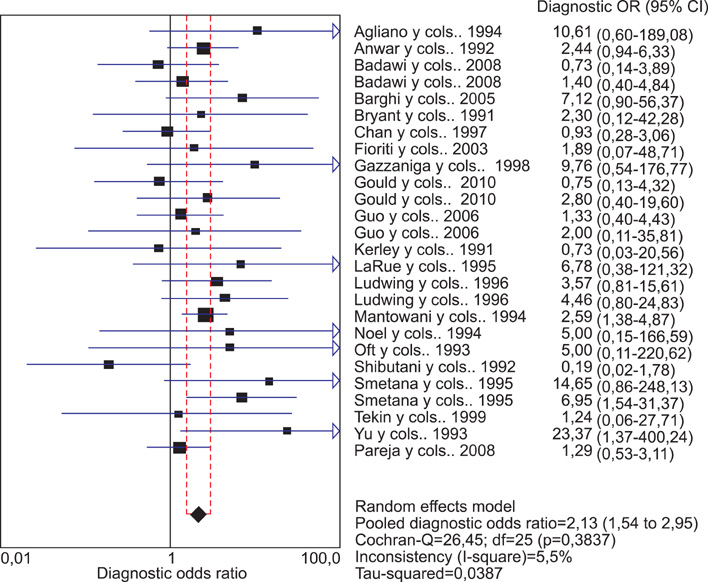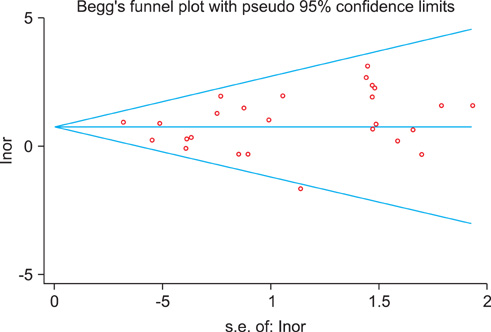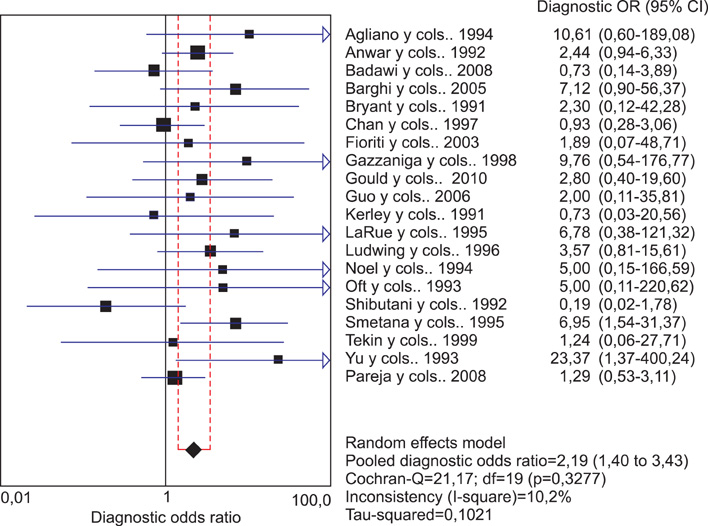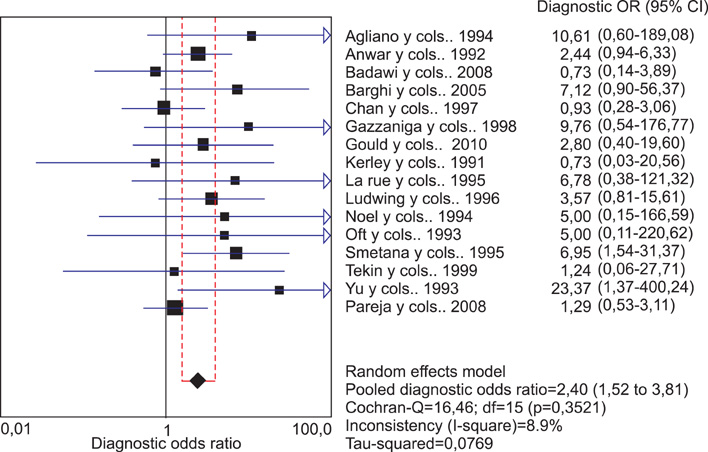Korean J Urol.
2012 Apr;53(4):240-247.
Meta-Analysis of Studies Analyzing the Role of Human Papillomavirus in the Development of Bladder Carcinoma
- Affiliations
-
- 1Department of Urology, Santa Ana Hospital, Granada, Spain. anjipa29@hotmail.com
- 2Department of Statistic, FIBAO, Virgen de las Nieves University Hospital, Granada, Spain.
- 3Department of Urology, San Cecilio University Hospital, Granada, Spain.
Abstract
- PURPOSE
We aimed to ascertain the degree of association between bladder cancer and human papillomavirus (HPV) infection.
MATERIALS AND METHODS
We performed a meta-analysis of observational studies with cases and controls with publication dates up to January 2011. The PubMed electronic database was searched by using the key words "bladder cancer and virus." Twenty-one articles were selected that met the required methodological criteria. We implemented an internal quality control system to verify the selected search method. We analyzed the pooled effect of all the studies and also analyzed the techniques used as follows: 1) studies with DNA-based techniques, among which we found studies with polymerase chain reaction (PCR)-based techniques and 2) studies with non-PCR-based techniques, and studies with non-DNA-based techniques.
RESULTS
Taking into account the 21 studies that were included in the meta-analysis, we obtained a heterogeneity chi-squared value of Qexp=26.45 (p=0.383). The pooled odds ratio (OR) was 2.13 (95% confidence interval [CI], 1.54 to 2.95), which points to a significant effect between HPV and bladder cancer. Twenty studies assessed the presence of DNA. The overall effect showed a significant relationship between virus presence and bladder cancer, with a pooled OR of 2.19 (95% CI, 1.40 to 3.43). Of the other six studies, four examined the virus's capsid antigen and two detected antibodies in serum by Western blot. The estimated pooled OR in this group was 2.11 (95% CI, 1.27 to 3.51), which confirmed the relationship between the presence of virus and cancer.
CONCLUSIONS
The pooled OR value showed a moderate relationship between viral infection and bladder tumors.
MeSH Terms
Figure
Reference
-
1. Ben Selma W, Ziadi S, Ben Gacem R, Amara K, Ksiaa F, Hachana M, et al. Investigation of human papillomavirus in bladder cancer in a series of Tunisian patients. Pathol Res Pract. 2010. 206:740–743.2. Moonen PM, Bakkers JM, Kiemeney LA, Schalken JA, Melchers WJ, Witjes JA. Human papilloma virus DNA and p53 mutation analysis on bladder washes in relation to clinical outcome of bladder cancer. Eur Urol. 2007. 52:464–468.3. Erill N, Colomer A, Verdú M, Román R, Condom E, Hannaoui N, et al. Genetic and immunophenotype analyses of TP53 in bladder cancer: TP53 alterations are associated with tumor progression. Diagn Mol Pathol. 2004. 13:217–223.4. Gould VE, Schmitt M, Vinokurova S, Reddy VB, Bitterman P, Alonso A, et al. Human papillomavirus and p16 expression in inverted papillomas of the urinary bladder. Cancer Lett. 2010. 292:171–175.5. Spano JP, Marcelin AG, Carcelin G. HPV and cancer. Bull Cancer. 2005. 92:59–64.6. Gutiérrez J, Jiménez A, de Dios Luna J, Soto MJ, Sorlózano A. Meta-analysis of studies analyzing the relationship between bladder cancer and infection by human papillomavirus. J Urol. 2006. 176(6 Pt 1):2474–2481.7. Aglianò AM, Gradilone A, Gazzaniga P, Napolitano M, Vercillo R, Albonici L, et al. High frequency of human papillomavirus detection in urinary bladder cancer. Urol Int. 1994. 53:125–129.8. Anwar K, Naiki H, Nakakuki K, Inuzuka M. High frequency of human papillomavirus infection in carcinoma of the urinary bladder. Cancer. 1992. 70:1967–1973.9. Badawi H, Ahmed H, Ismail A, Diab M, Moubarak M, Badawy A, et al. Role of human papillomavirus types 16, 18, and 52 in recurrent cystitis and urinary bladder cancer among Egyptian patients. Medscape J Med. 2008. 10:232.10. Barghi MR, Hajimohammadmehdiarbab A, Moghaddam SM, Kazemi B. Correlation between human papillomavirus infection and bladder transitional cell carcinoma. BMC Infect Dis. 2005. 5:102.11. Bryant P, Davies P, Wilson D. Detection of human papillomavirus DNA in cancer of the urinary bladder by in situ hybridisation. Br J Urol. 1991. 68:49–52.12. Chan KW, Wong KY, Srivastava G. Prevalence of six types of human papillomavirus in inverted papilloma and papillary transitional cell carcinoma of the bladder: an evaluation by polymerase chain reaction. J Clin Pathol. 1997. 50:1018–1021.13. Fioriti D, Pietropaolo V, Dal Forno S, Laurenti C, Chiarini F, Degener AM. Urothelial bladder carcinoma and viral infections: different association with human polyomaviruses and papillomaviruses. Int J Immunopathol Pharmacol. 2003. 16:283–288.14. Gazzaniga P, Vercillo R, Gradilone A, Silvestri I, Gandini O, Napolitano M, et al. Prevalence of papillomavirus, Epstein-Barr virus, cytomegalovirus, and herpes simplex virus type 2 in urinary bladder cancer. J Med Virol. 1998. 55:262–267.15. Guo CC, Fine SW, Epstein JI. Noninvasive squamous lesions in the urinary bladder: a clinicopathologic analysis of 29 cases. Am J Surg Pathol. 2006. 30:883–891.16. Kerley SW, Persons DL, Fishback JL. Human papillomavirus and carcinoma of the urinary bladder. Mod Pathol. 1991. 4:316–319.17. LaRue H, Simoneau M, Fradet Y. Human papillomavirus in transitional cell carcinoma of the urinary bladder. Clin Cancer Res. 1995. 1:435–440.18. Ludwig M, Köchel HG, Fischer C, Ringert RH, Weidner W. Human papillomavirus in tissue of bladder and bladder carcinoma specimens. A preliminary study. Eur Urol. 1996. 30:96–102.19. Mantovani G, Cermelli C, Malagoli M, Provvisionato A, Ferrari P, Castagnetti M, et al. IgG antibodies to papillomavirus genus-antigens in adult men with cancer of the urinary bladder. New Microbiol. 1994. 17:1–8.20. Noel JC, Peny MO, Mat O, Antoine M, Firket C, Detremmerie O, et al. Human papillomavirus type 16 associated with multifocal transitional cell carcinomas of the bladder in two transplanted patients. Transpl Int. 1994. 7:340–343.21. Oft M, Böhm S, Wilczynski SP, Iftner T. Expression of the different viral mRNAs of human papilloma virus 6 in a squamous-cell carcinoma of the bladder and the cervix. Int J Cancer. 1993. 53:924–931.22. Shibutani YF, Schoenberg MP, Carpiniello VL, Malloy TR. Human papillomavirus associated with bladder cancer. Urology. 1992. 40:15–17.23. Smetana Z, Keller T, Leventon-Kriss S, Huszar M, Lindner A, Mitrani-Rosenbaum S, et al. Presence of human papilloma virus in transitional cell carcinoma in Jewish population in Israel. Cell Mol Biol (Noisy-le-grand). 1995. 41:1017–1023.24. Tekin MI, Tuncer S, Aki FT, Bilen CY, Aygün C, Ozen H. Human papillomavirus associated with bladder carcinoma? Analysis by polymerase chain reaction. Int J Urol. 1999. 6:184–186.25. Yu ST, Wu MM, Li LM. Prevalence of human papillomaviruses 16 and 18 in transitional cell carcinoma of bladder. Chin Med J (Engl). 1993. 106:494–496.26. Yavuzer D, Karadayi N, Salepci T, Baloglu H, Bilici A, Sakirahmet D. Role of human papillomavirus in the development of urothelial carcinoma. Med Oncol. 2011. 28:919–923.27. Knowles MA. Human papillomavirus sequences are not detectable by Southern blotting or general primer-mediated polymerase chain reaction in transitional cell tumours of the bladder. Urol Res. 1992. 20:297–301.28. Pareja Vilchez M. Detection of the human papillomavirus in samples of bladder cancer by a DNA hybridization test. Clinical Relations [tesis doctoral]. 2008. Granada: Granada Univ..29. Scheffner M, Werness BA, Huibregtse JM, Levine AJ, Howley PM. The E6 oncoprotein encoded by human papillomavirus types 16 and 18 promotes the degradation of p53. Cell. 1990. 63:1129–1136.30. Li N, Yang L, Zhang Y, Zhao P, Zheng T, Dai M. Human papillomavirus infection and bladder cancer risk: a meta-analysis. J Infect Dis. 2011. 204:217–223.31. Furihata M, Inoue K, Ohtsuki Y, Hashimoto H, Terao N, Fujita Y. High-risk human papillomavirus infections and overexpression of p53 protein as prognostic indicators in transitional cell carcinoma of the urinary bladder. Cancer Res. 1993. 53:4823–4827.
- Full Text Links
- Actions
-
Cited
- CITED
-
- Close
- Share
- Similar articles
-
- The Study on the Relevance between Human Papillomavirus (HPV) Infections and Transitional Cell Carcinoma of the Urinary Bladder in Korean
- Synchronous Verrucous Carcinoma and Squamous Cell Carcinoma of Penis by Different Human Papillomavirus Infections
- Analysis of p53 tumor suppressor gene mutations and human papillomavirus infection in human bladder cancers
- Why Should You Care About Oral Gonorrhea and Oral Human Papillomavirus Infection?
- Methods for Detection of Human Papillomavirus in Head and Neck Cancer







